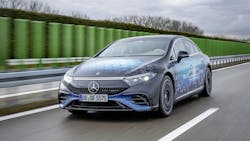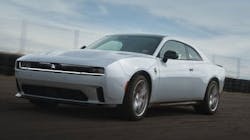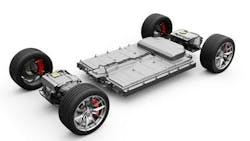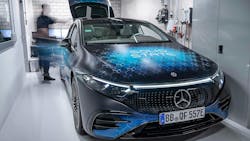Solid-State Batteries Move from Research to Reality
What you’ll learn:
- Stellantis’ and Factorial Energy’s successful validation of automotive-sized solid-state battery cells with 375 Wh/kg energy density.
- Stellantis will incorporate Factorial’s solid-state batteries into a demonstration fleet by 2026.
- Mercedes just made history by driving the first-ever EV powered by a solid-state battery.
The years 2025-2026 will be a watershed moment in time for the development of solid-state batteries (SSBs) for electric vehicles. By way of review, solid-state batteries for EVs offer significant advantages over nickel-manganese-cobalt (NMC) and lithium-iron-phosphate (LFP) batteries, promising increased energy density, safety, and faster charging times. These batteries use a non-liquid electrolyte, potentially leading to improved thermal stability and reducing the risk of fire.
Here are some recent examples:
Stellantis N.V. and Factorial Energy announced the successful validation of Factorial’s automotive-sized FEST (Factorial Electrolyte System Technology) quasi-solid-state battery cells.
Factorial will supply Stellantis with cells based on its proprietary FEST technology, which enables a specific energy density of over 390 Wh/kg. This makes it well-suited for powering next-generation EVs.“Semi-solid or quasi-solid electrolytes, also known as gel or hybrid electrolytes, aim to combine the safety advantages of solid-state electrolytes with the improved performance and manufacturability of liquid electrolytes. These electrolytes are composed of a solid matrix infused with a liquid or gel-like electrolyte. The solid matrix provides structural and thermal stability (thus usable with lithium metal anodes) while the liquid or gel component facilitates ion transportation, flexibility, and interface ‘snugness.’
Quasi- or semi-solid electrolytes offer a good compromise, providing enhanced safety compared to conventional liquid electrolytes. They exhibit reduced flammability due to the immobilization of the liquid component within the solid matrix. Importantly, they can provide high ionic conductivity at room temperature compared to traditional solid electrolytes.”—Dr. Raimund Koerver, Director of Innovation at Factorial Energy
Stellantis selected the STLA Large multi-energy platform (a BEV-native platform designed to fit a wide range of vehicles, including cars, crossovers, and SUVs, across five brands by 2026) for FEST. The STLA Large platform, a cornerstone of Stellantis' Dare Forward 2030 strategic plan, includes brands such as Alfa Romeo, Chrysler, Dodge, Jeep, and Maserati. It’s designed to support up to two million vehicles globally.
Factorial's FEST is said to offer substantial advantages over traditional lithium-ion batteries, including higher energy density, faster charging reduced weight, improved performance, and a potential for further reduction in total vehicle cost over time. The 77-Ah lithium-metal quasi-solid-state FEST cells demonstrated an energy density of 375 Wh/kg with over 600 cycles progressing toward automotive qualification.
According to Factorial, the cells enable a significant reduction in charging time, from 15% to over 90% charge in just 18 minutes at room temperature. In addition, the cells deliver high power output with discharge rates up to 4C, supporting greater performance demands in electric vehicles.
Leveraging Factorial’s latest electrolyte formulation, the battery can perform in temperatures ranging from −30 to 45°C (−22 to 113°F).
"Battery development is about compromise. While optimizing one feature is simple, balancing high energy density, cycle life, fast charging, and safety in an automotive-sized battery with OEM validation is a breakthrough," said Siyu Huang, CEO of Factorial Energy. "This achievement with Stellantis is bringing next-generation battery technology from research to reality."
By collaborating on pack design and leveraging this technology, Stellantis and Factorial are optimizing battery-pack architecture to reduce weight and improve overall system efficiency for seamless integration. These weight savings directly enhance vehicle range and support more sustainable and affordable EV solutions.
With this development, Stellantis will advance its previously announced plan to integrate Factorial's quasi-solid-state batteries into a demonstration fleet by 2026. This demonstration fleet represents the next step toward commercializing this technology.
Mercedes Solid-State Battery Vehicle Hits the Road
This news follows the launch of Solstice, developed by Factorial in partnership with Mercedes-Benz to complement Factorial’s FEST offering. The core cell architecture features a lithium-metal anode, a high-capacity cathode, and a zero-liquid, sulfide-based, solid electrolyte. Solstice employs a novel dry coating process for cathode manufacturing, which eliminates hazardous solvents and energy-intensive steps that “drive off” the solvents, enhancing sustainability and reducing both production costs and environmental impact.
Mercedes just made history by driving the first-ever EV powered by a solid-state battery. Solid-state EV batteries have been in development for over a decade, but this is the first time any company has ever installed one into a car and then driven it (on a testing track and not on public roads).
Solstice, at 450 Wh/kg is considerably more energy-dense than the current lithium-ion (Li-ion) batteries that dominate the EV industry. Mercedes said that its new solid-state battery increases range by 25% over a similarly sized Li-ion battery of about the same weight.
In addition to passenger vehicles, Solstice can be used for other applications such as energy storage, consumer electronics, and commercial vehicles.



